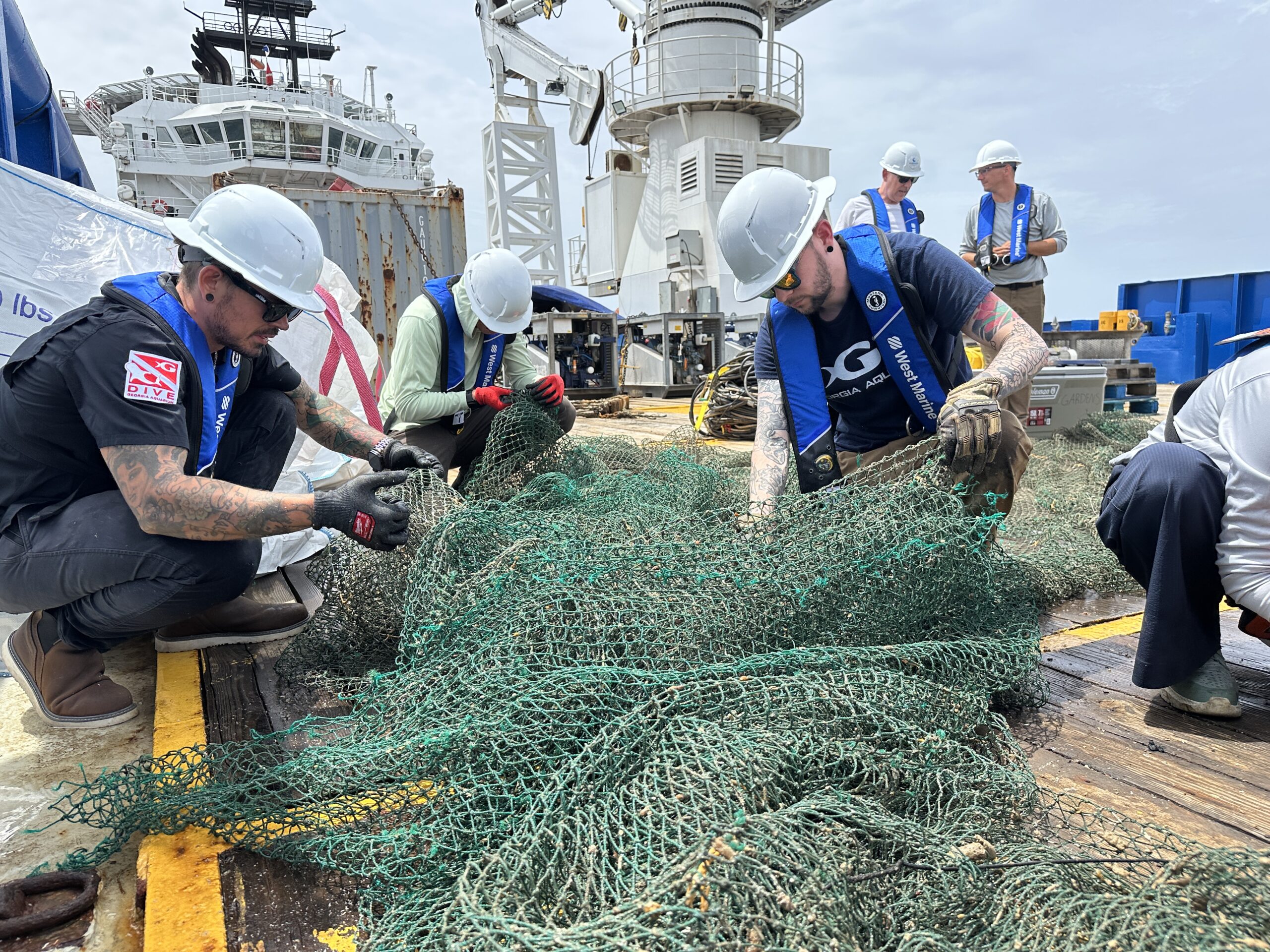
Silver Spring, Md. – July 28, 2025 – From June 27-July 2, the National Marine Sanctuary Foundation completed a targeted large marine debris removal effort in Flower Garden Banks National Marine Sanctuary, alongside partners at the National Oceanic and Atmospheric Administration’s (NOAA) Flower Garden Banks National Marine Sanctuary, Mesophotic and Deep Benthic Communities portfolio and Marine Debris Program; Moody Gardens; Georgia Aquarium; Anchor Diving, and T&T Group.
Flower Garden Banks National Marine Sanctuary, the only marine sanctuary in the Gulf, lies one hundred miles off the Texas and Louisiana coasts. This marine sanctuary protects incredible marine life like manta rays, sea turtles, and whale sharks, and serves as a hub for science and restoration efforts, particularly of mesophotic coral ecosystems. It is also a popular area for scuba diving and recreational and commercial fishing.
This marine debris removal is one of the few targeted marine debris removals conducted in the mesophotic zone in the Gulf, operating at depths rarely addressed by cleanup missions. Mesophotic refers to the “middle light” zone where there is little sunlight, home to coral and sponge communities adapted to live in low light. This zone supports high biodiversity and plays an important role in the broader ecosystem function of Flower Garden Banks.
This marine debris removal mission brings together scientific oversight, commercial diving, and crane operations to remove derelict fishing gear that has been fouling the seafloor for years – damaging habitat, creating entanglement risks for marine life, and getting in the way of recovery, research, and recreation activities. It builds on recent debris assessments and represents a data-driven, collaborative approach to restoring deep reef ecosystems. The removal of this marine debris protects the marine ecosystem, which in turn provides benefits for local businesses, recreational and commercial fishers, and scuba divers.
“Flower Garden Banks plays a critical role supporting state economies and local livelihoods. Through long-term collaboration between federal government and universities, and local businesses like fishing charters, dive shops, and aquariums, Flower Garden Banks National Marine Sanctuary has become a model of public-private partnership and how marine sanctuaries can facilitate responsible enterprise,” said Joel R. Johnson, President & CEO of the National Marine Sanctuary Foundation.
Most of the debris targeted for removal is on Stetson Bank, including derelict fishing gear (including trawl nets, fishing line, and rope), anchors, and human-made debris (such as plastic and metal fragments).
T&T Group provided the vessel, crane operations, and commercial dive teams, who carried out 24-hour operations to locate, rig, and recover the debris. Moody Gardens and Georgia Aquarium staff assisted in onboard operations, helped manage and assess recovered materials, supported the in-water decision-making process, and contributed to overall mission logistics. NOAA staff representing the Mesophotic and Deep Benthic Communities portfolio were onboard to oversee the project, ensure adherence to marine sanctuary protocols, collect photos and videos of the work, and collect data on the type, condition, and state of the ecosystem. The National Marine Sanctuary Foundation provided key logistical and financial support to help enable the operation and coordination among partners.
This project is supported by the NOAA Marine Debris Program. It includes large marine debris removal across five national marine sanctuaries, including Flower Garden Banks National Marine Sanctuary.
###
The National Marine Sanctuary Foundation, established in 2000, is the official non-profit partner of the National Marine Sanctuary System. The Foundation directly supports America’s national marine sanctuaries through our mission to protect species, conserve ecosystems and preserve cultural and maritime heritage. We accomplish our mission through community stewardship and engagement programs, on-the-water conservation projects, public education and outreach programs, and scientific research and exploration. The Foundation fosters innovative projects that are solution-oriented, scalable and transferable, and develop strategic partnerships that promote the conservation and recovery of species and their habitats. Learn more at marinesanctuary.org.
Contact: Shannon Colbert
Senior Vice President, External Affairs
202-870-0387
